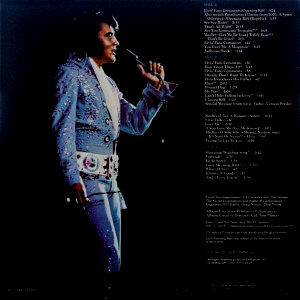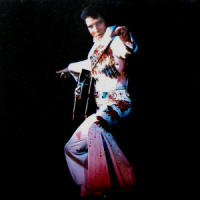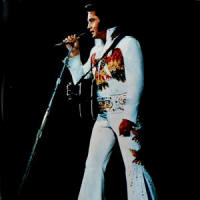



RCA Records synchronized the release of
"Elvis In Concert"
to the airing of the tv special and put the
double album in the stores on October 3, 1977.
With preorders of over a million units the set
entered Billboard's "Top LPs Chart" on October
29th, stayed for 18 weeks and finally reached
number 5. On the same day the release also made
it into the "Hot Country LPs Chart". Here it was
listed for 37 weeks and became a number one hit.
Because of the preorders the RIAA honored "Elvis
In Concert" with a Platinum Award as soon as it
was released, in 2002 it was updated to Tripple
Platinum. In Europe and Asia the double album
also sold very well and made it into the Top10s
of many countries. In total "Elvis In Concert"
sold 4.5 million units, which would be 650
million paid streams of the album, respectively
6.5 billion paid streams of individual tracks
today. Thus it sold three times as much as "Elvis
Recorded Live On Stage In Memphis" (1974),
it
still failed to match the sales of "Aloha From
Hawaii Via Satellite" (1973, 10 million units)
and "Elvis As Recorded At Madison Square Garden"
(1972, 5 million units).
"Elvis In Concert" can be found on the
various streaming platforms, but only in 16 bit
/ 44.1 khz. The reason is, that this longplayer
was not part of Sony's "The Album Collection"
and therefore the digital version was produced
before 2016. On Spotify, which has a market
share of approximately 30% and is the only
platform that publishes streaming figures,
"Elvis In Concert" accumulates 11 million
streams. In contrast to the king's final studio
recordings, his last concert performances don't
draw too much attention.
Even though Elvis' recent condition was
obvious in the tv special, Colonel Parker and
RCA Records stuck to their procedure of using
older pictures for the packaging. The photo on
the front cover was made in 1975, the one on the
back in 1972. The image used on the inner sides
were taken in 1974. Combined both records of the
set have a running time of 71:41 minutes.
The tracks were recorded on June 19, 1977 in
Omaha/Nebraska and on June 21, 1977 in Rapid
City/South Dakota. The live sessions were
produced by Dwight Hemion, Gary Smith and Felton
Jarvis, Bill Harris and Dough Nelson handled the
engineering. The band was made up of James
Burton (guitar), John Wilkinson (guitar), Ronnie
Tutt (drums), Jerry Scheff (bass), Tony Brown
(piano), Bobby Odgin (keyboard) and Charlie Hodge
(guitar & harmony vocals). Joe Guercio conducted
a ten-person orchestra, harmony vocals were
provided by J.D. Sumner & The Stamps (Larry
Strickland, Ed Hill, Ed Enoch and Gary Buckles)
and The Sweet Inspirations (Myrna Smith, Sylvia
Shemwell and Estelle Brown) as well as Kathy
Westmoreland and Sherrill Nielsen.
On August 29th and 30th additional harmony
vocals were recorded at the Young 'un Sound
Studio in Murfreesboro/Tennessee, after that
further instruments were added at the
Soundmaster Studio in Nashville/Tennessee.
The first longplayer contains the soundtrack
of the television special minus "Early Morning
Rain" which had been added at the last minute.
The second disc features additional live
recordings. Most of the tracks had been recorded
on June 21st in Rapid City, just the medley of
"Teddy Bear" and "Don't Be Cruel", "How Great
Thou Art", "Can't Help Falling In Love",
"Fairytale", "Little Sister" and "And I Love You
So" came from the Omaha show on June 19th.
Elvis' Fans Comments/Opening Riff
The album starts with various statements of
enthusiastic fans with the "Opening Riff" edited
in-between.
Also Sprach ZarathustraThe
orchestra performs the "Einleitung, oder
Sonnenaufgang" from Richard Strauss' classical
opus "Also Sprach Zarathustra". Elvis uses this
piece since half a decade, it's also featured on
"Elvis As Recorded At Madison Square Garden"
(1972) and "Aloha From Hawaii Via Satellite"
(1973).
See See RiderAs soon as the
final note of the famous piece is played the
band takes over with the rhythmical "Opening
Riff" to which the king enters the stage and
collects his guitar from Charlie Hodge. As he
walks to the microphone in the middle of the
stage, his musicians move seamlessly to "See See
Rider", the first song of the show. It can also
be heared on "On Stage - February 1970" (1970),
"Aloha From Hawaii Via Satellite" (1973) and
"Elvis Recorded Live On Stage In Memphis"
(1974).
Compared to these performances Elvis sounds
considerably older, at times with a nasal and
tired undertone.
That's All RightOn "Elvis As
Recorded At Madison Square Garden" (1972) the
singer delivered a punchy high speed-version of
this song. By now he has reduced the tempo and
the arrangement tends more to be country &
western again. I like this more basic, less
vegasy style very much. Elvis also seems to
enjoy the song, he's very much into it. But it's
still not very good, because Elvis' bad
condition is very obvious in his voice.
Are You Lonesome TonightA
live recording of this one had already been
featured on "From Memphis To Vegas / From Vegas
To Memphis" (1969), but here Elvis has returned
to the original arrangement, too. It's
a nice performance until he reaches the spoken
part and gets muddled. He tries to make fun out
of the situation, but sounds somewhat helpless
and out of breath.
Teddy Bear / Don't Be Cruel
This medley is well known from the album "Elvis
As Recorded At Madison Square Garden" and
without doubt the fans must have asked
themselves what had happened to the king in the
previous five years. All of his energy is gone,
his voice sounds powerless, bored and nasal.
It's a piss-poor performance.
Elvis' Fans CommentsNow the
live recordings are interrupted by statements of
fans. One example is a lady who tells the people
about Elvis' honesty. Well, after his
death many incidents became public that
demonstrate the opposite.
You Gave Me A MountainThe
power ballad was featured in the movie "Elvis On
Tour" (1972) and was also part of the album
"Aloha From Hawaii Via Satellite" (1973).
Nowadays the singer cuts several lines short to
give himself an opportunity to take a breath.
But he does it in a very skillful way and one
has to know the earlier recordings to realize
the regression. Elvis performs the song in a
very emotional way and his voice also sounds
stronger and warmer than on the preceding songs.
Jailhouse RockFinally we get
to hear something not included in one of the
king's many previous live albums. The "Jailhouse
Rock" is presented in a fast, Vegas styled
version. It hasn't much to do with the agressive
studio cut from 1957, but it works well if you
consider it just a reminder of the good old
days. At one point Elvis messes up the lyrics
and seems to be amused by his memory lapse. With
this performance we leave side a of the record.
Elvis' Fans CommentsWhereas
the fans believed in Elvis' honesty on the last
comments-clip, they are now sure of his
religiousity.
How Great Thou ArtOf course
a statement like this has to lead to a gospel
song. In early 1975 the king had received a
Grammy Award for his performance of "How Great
Thou Art" on the album "Elvis Recorded Live On
Stage In Memphis". Unfortunately Elvis doesn't
even come close to what he had delivered on
March 20, 1974. At times his voice lacks
control, he misses several notes and tries to
cover his fatigue by singing some lines very
loud. But everytime he does, the strength soon
leaves him and he has to catch his breath. Here
and there he still manages to sound impressive,
but in total he cannot compete with his previous
effort.
Elvis' Fans CommentsNow Todd
Slaughter, the president of the British fanclub,
tells us about the trip of the fanclub to
America and of his impressions of the king.
I Really Don't Want To Know
This is the second song that wasn't featured on
any of Elvis' previous live albums. The studio
recording was released in 1971 on "Elvis Country
- I'm 10,000 Years Old". At the time the singer
sounded very powerful, almost angry. Now he
appears to have given up, just accepting that
his lady had many lovers in the past. It's a
short, but nevertheless great performance.
Elvis' voice sounds very good here and he sings
with a lot of emotion. To me this is the
highlight of the album.
Elvis Introduces His Father
The king introduces Vernon and explains that he
was sick and couldn't accompany him on tour for
a while. He also introduces Ginger Alden, his
girlfriend.
HurtHere we have the third
new live song of the album. The power ballad was
released in 1976 on a single and on the album
"From Elvis Presley Boulevard, Memphis,
Tennessee". On stage "Hurt" is played at a
faster tempo, but the king delivers a very
emotional and well sung version.
Hound DogThe rock'n'roll
classic "Hound Dog" is another matter
altogether. Elvis just repeats the same four
lines over and over again, his voice sounds
weak, tired and bored. Thankfully it's only a
sound recording and we didn't have to see him
shaking his hind end.
My WayElvis has presented
this song in 1973 on his album "Aloha From
Hawaii Via Satellite". Vocally he cannot compete
with his previous effort, the performance
obviously costs him strength and at times he
even sounds out of breath. But the new
arrangement offers more drama and the knowledge
of Elvis' soon demise extendes this effect.
Because a lot of radio stations started to
play "My Way" to commemorate the king, RCA
Records also released the recording on a
single.
It was a clever move, because the 45 sold over 3
million units.
Can't Help Falling In LoveAs
usual Elvis closes the show with the classic
ballad from his movie "Blue Hawaii". This
version, however, lacks all the beauty of the
studio recording. The king is just going through
the motions and doesn't seem to care at all.
Closing Riff / Special Message From
Elvis' FatherThe closing is followed
by a short message from Vernon. He is obviously
devastated by the death of his son, but still he
takes some time to thank everyone for the
flowers and cards that were sent to Graceland.
With this message the first record of the set
ends.
I Got A Woman/AmenThe second
longplayer of the set contains additional
recordings from June 19th and June 21st and can
be regarded as some kind of bonus. The first
song was also included on "Elvis Recorded Live
On Stage In Memphis" and once more one cannot
avoid to realize the difference.
Elvis TalksThe entertainer
welcomes the crowd and remarks that somebody (it
was the major of Rapid City!) had mentioned to
him that he was the first person to perform in
the new building.
Love MeThis song has been a
part of Elvis' three previous live albums and
this version is the worst. He just sounds old
here.
If You Love Me (Let Me Know)
A performance from April 1977 can be found on
"Moody Blue" and I have to say that "If You Love
Me (Let Me Know)" doesn't sound all that
different in June. It's an acceptable
performance, but nothing to write home about.
O Sole Mio / It's Now Or Never
Even though "It's Now Or Never" is Elvis' best
selling record, it hasn't been included in any
live album so far. Sherrill Nielsen sings "O
Sole Mio", the classic Italian song Elvis' hit
is based on. It's not a serious performance, Mr.
Nielsen howls the highest notes for comical
effect. The audience and the king seem to enjoy
it. Then Elvis takes over with "It's Now Or
Never". The arrangement is a little overblown,
but Elvis sings well.
Trying To Get To YouThe SUN
classic was also featured on "Elvis Recorded
Live On Stage In Memphis" and so I cannot help
to compare the performances. Just three years ago
the king sounded powerful, vital and flexible.
Now his voice is tired and has a nasal
undertone. He more and more gets going and
sounds even impressive at times, but in total he
neither sounds like a man of 42 years nor like a
healthy man at all.
Hawaiian Wedding SongElvis'
is breathing heavily and his voice has a fragile
touch. Once again he appears to be much older
than he really is. It guess the reason for
putting this track on the album was the simple
fact, that the "Hawaiian Wedding Song" wasn't
included in the previous concert releases.
FairytaleBecause Elvis had
released the peppy country song in 1975 it can't
be found on any of his live albums. Felton
Jarvis tried to cover the tired and nasal vocals
of his employer by recording additonal harmony
voices, but he couldn't save the track. It's
tolerable, but nothing more.
Little SisterThis classic
from the early 1960s had also not been released
on a live album before. Unfortunately the
performance lacks the drive of the studio
recording and Elvis sounds almost twice is age.
Early Morning RainHere the
king delivers an atmospheric and believable
performance. But honestly I think his condition
just fits the song by coincidence. "Early
Morning Rain" wasn't part of any live album before.
What'd I SayThe same applies
to this classic by Ray Charles. Unfortunately
Elvis does just 45 seconds of the song and
sounds bored to death.
Johnny B. GoodeNow the king
butchers a Chuck Berry song. On "From Memphis To
Vegas / From Vegas To Memphis" he delivered
nothing but the ultimate performance of that
tune. His rendition on the album "Aloha From
Hawaii Via Satellite" already left a lot to be
desired, but this one here takes the cake. Pure
embarrassment.
And I Love You SoThis
beautiful ballad was released in 1975 on an
album called "Elvis Today". Once again the king
is unable to match his studio effort. He sounds
uncontrolled, old and tired. At times one might
fear that the singer falls asleep in mid song.
Felton Jarvis once again tried to save the track
by overdubbing voices and instruments, but
unfortunately he was just a producer, not a
magician.
Verdict
Compared to "Elvis Recorded Live On Stage
In Memphis" the decline of the singer is
obvious. In these three years Elvis seems to
have aged several decades and there is not
much left of the vitality and joy of
performing. In June 1977 the spark was gone
and it's sad to hear him that way.

(C) RCA Victor
![]()

